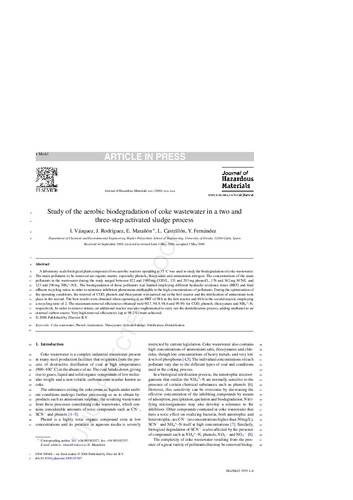Study of the aerobic biodegradation of coke wastewater in a two and three-step activated sludge process
Subject:
Coke wastewater
Phenol
Ammonium
Thiocyanate
Activated sludge
Nitrification
Denitrification
Publication date:
Editorial:
Elsevier
Publisher version:
Citación:
Descripción física:
Abstract:
A laboratory-scale biological plant composed of two aerobic reactors operating at 35 ◦C was used to study the biodegradation of coke wastewater The main pollutants to be removed are organic matter, especially phenols, thiocyanate and ammonium nitrogen. The concentrations of the main pollutants in the wastewater during the study ranged between 922 and 1980 mg COD/L, 133 and 293 mg phenol/L, 176 and 362 mg SCN/L and 123 and 296 mg NH4 +–N/L. The biodegradation of these pollutants was studied employing different hydraulic residence times (HRT) and final effluent recycling ratios in order to minimize inhibition phenomena attributable to the high concentrations of pollutants. During the optimisation of the operating conditions, the removal of COD, phenols and thiocyanate was carried out in the first reactor and the nitrification of ammonium took place in the second. The best results were obtained when operating at an HRT of 98 h in the first reactor and 86 h in the second reactor, employing a recycling ratio of 2. The maximum removal efficiencies obtained were 90.7, 98.9, 98.6 and 99.9% for COD, phenols, thiocyanate and NH4 +–N, respectively. In order to remove nitrate, an additional reactor was also implemented to carry out the denitrification process, adding methanol as an external carbon source. Very high removal efficiencies (up to 99.2%) were achieved.
A laboratory-scale biological plant composed of two aerobic reactors operating at 35 ◦C was used to study the biodegradation of coke wastewater The main pollutants to be removed are organic matter, especially phenols, thiocyanate and ammonium nitrogen. The concentrations of the main pollutants in the wastewater during the study ranged between 922 and 1980 mg COD/L, 133 and 293 mg phenol/L, 176 and 362 mg SCN/L and 123 and 296 mg NH4 +–N/L. The biodegradation of these pollutants was studied employing different hydraulic residence times (HRT) and final effluent recycling ratios in order to minimize inhibition phenomena attributable to the high concentrations of pollutants. During the optimisation of the operating conditions, the removal of COD, phenols and thiocyanate was carried out in the first reactor and the nitrification of ammonium took place in the second. The best results were obtained when operating at an HRT of 98 h in the first reactor and 86 h in the second reactor, employing a recycling ratio of 2. The maximum removal efficiencies obtained were 90.7, 98.9, 98.6 and 99.9% for COD, phenols, thiocyanate and NH4 +–N, respectively. In order to remove nitrate, an additional reactor was also implemented to carry out the denitrification process, adding methanol as an external carbon source. Very high removal efficiencies (up to 99.2%) were achieved.
ISSN:
Patrocinado por:
European Union (ECSC) Proyect BIOCONTROL (Ref. No. 72010-PR-235)
Collections
- Artículos [37548]
- Ingeniería Química y Tecnología del Medio Ambiente [354]
Files in this item




